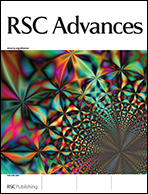Influence of plasma protein–hydrogel interaction moderated by absorption of water on long-term cell viability in amphiphilic biosynthetic hydrogels
Abstract
Studies on the effect of plasma protein binding on biosynthetic hydrogels on the long term cell viability and infiltration onto the hydrogel scaffolds were carried out. Three hydrogels, PALG–P (PALG-co-PEGDA), PALG–PA (PALG-co-PEGDA-co-AA) and PALG–PB (PALG-co-PEGDA-co-BMA) were prepared using a copolymer of poly(propylene fumarate)-co-alginate (PALG) and cross-linker PEGDA and vinyl monomers. The nature of vinyl monomer largely influences the nature of water (structured bound water/freezing free water) present in the hydrogel and also the adsorption of protein, cell growth and infiltration. The extensively bound structured water as observed with butyl methacrylate based poly(propylene fumarate)-co-alginate-PEGDA hydrogel (PALG–PB) do not favour absorption of proteins and sustain cell growth and infiltration for long duration. Though moderately bound structured water favours absorption of protein moderately as observed with poly(propylene fumarate)-co-alginate-PEGDA hydrogel (PALG–PB), it does not sustain the cell growth. However, the minimally bound structured water favours absorption of protein extensively as observed with acrylic acid based poly(propylene fumarate)-co-alginate-PEGDA hydrogel (PALG–PA) and sustains the cell growth and infiltration for long duration.


 Please wait while we load your content...
Please wait while we load your content...